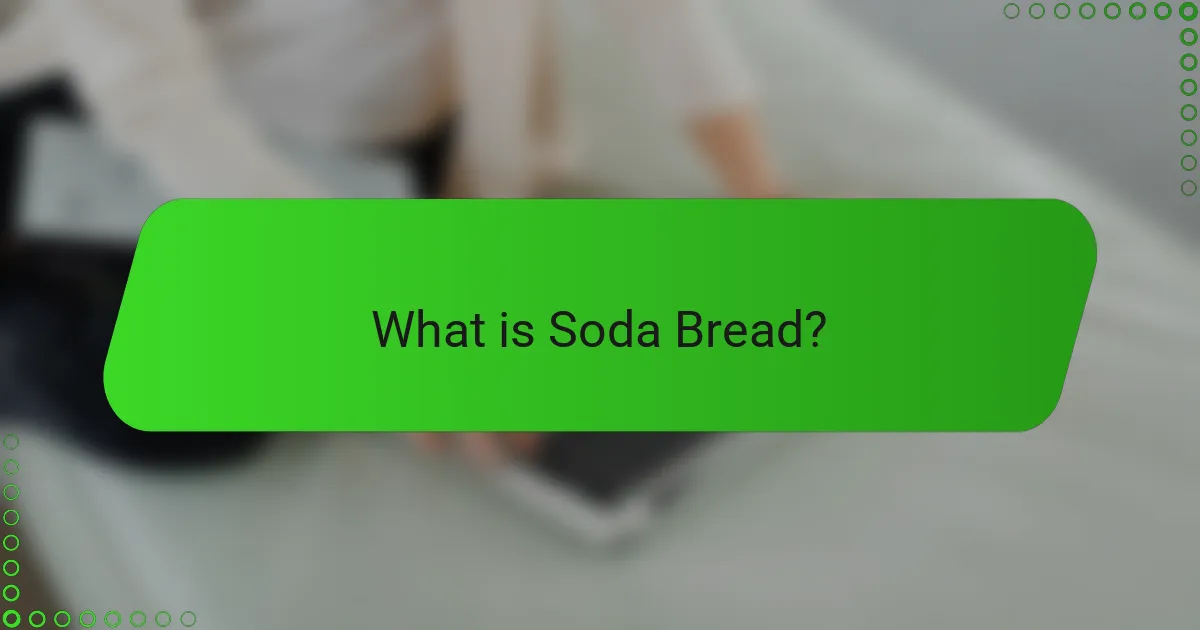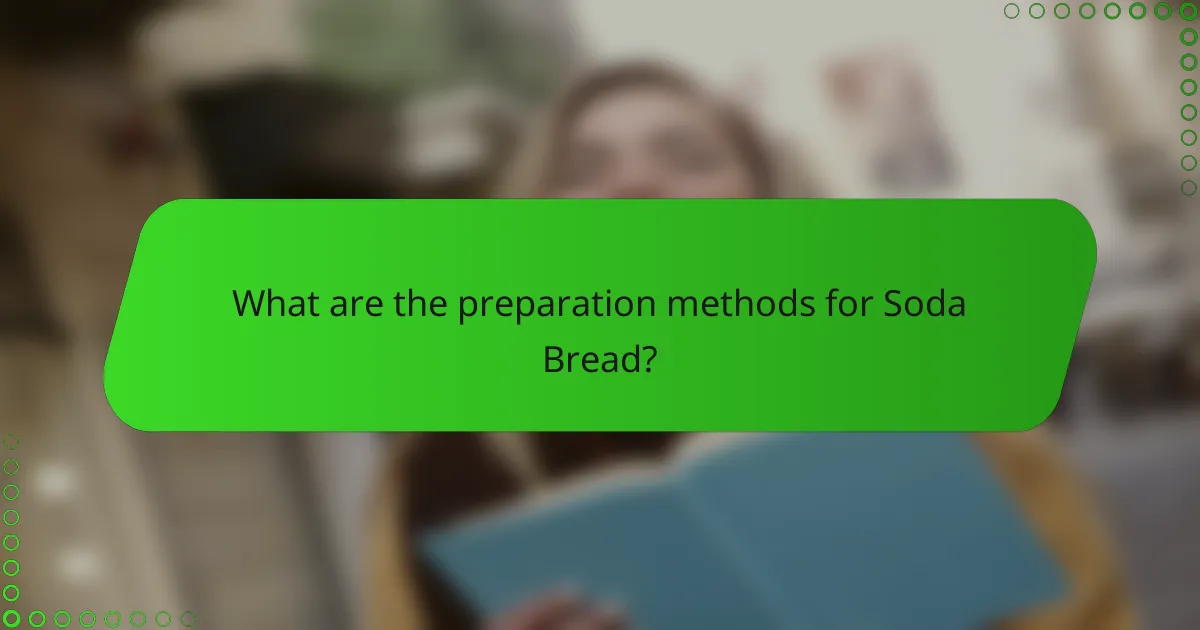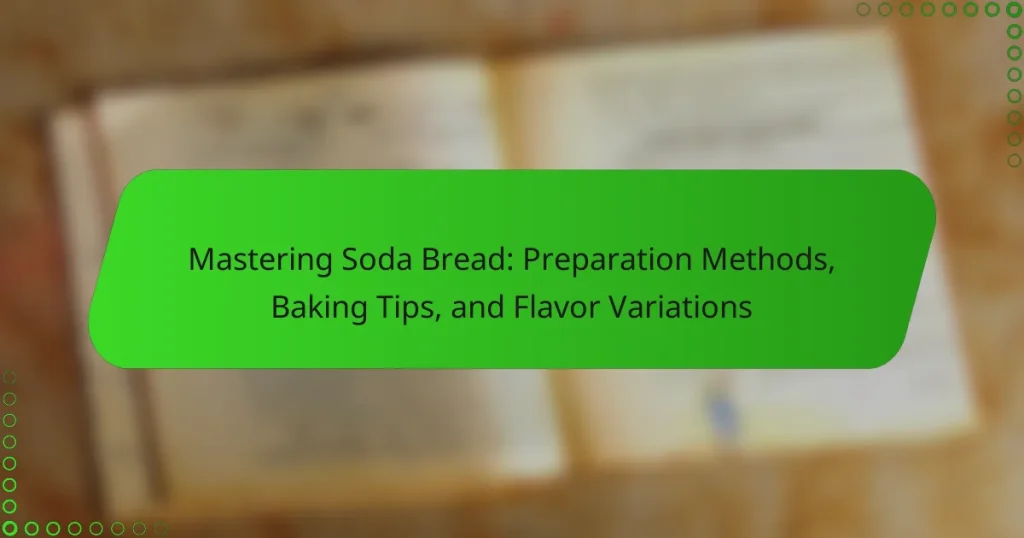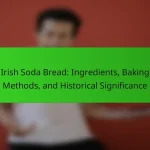Soda bread is a traditional Irish quick bread that utilizes baking soda as a leavening agent instead of yeast, resulting in a dense texture and slightly tangy flavor. The article covers various preparation methods, emphasizing the simplicity of ingredients such as flour, water, salt, and buttermilk, which contribute to its quick baking process. It provides essential baking tips to enhance the bread’s texture and flavor, such as using fresh ingredients and proper mixing techniques. Additionally, the article explores flavor variations, including sweet additions like raisins and savory options like cheese and herbs, catering to diverse tastes and preferences.

What is Soda Bread?
Soda bread is a type of quick bread that uses baking soda as a leavening agent instead of yeast. It is traditionally made with flour, water, and salt. The use of baking soda allows for a faster preparation time. Soda bread originated in Ireland in the 19th century. The bread has a dense texture and a slightly tangy flavor due to the reaction of baking soda with acidic ingredients like buttermilk. Soda bread can be made with various flours, including whole wheat or all-purpose flour. It is commonly served with butter or jam. The simplicity of its ingredients makes it a staple in Irish cuisine.
How is Soda Bread different from other types of bread?
Soda bread differs from other types of bread primarily due to its leavening agent. While most breads use yeast for rising, soda bread relies on baking soda. This chemical reaction occurs when baking soda combines with an acid, like buttermilk, producing carbon dioxide bubbles. These bubbles create the bread’s light texture. Additionally, soda bread typically has a denser crumb compared to yeast-leavened breads. It is also quicker to prepare, requiring no time for dough fermentation. Traditional soda bread is often made with simple ingredients like flour, salt, baking soda, and buttermilk. This simplicity contrasts with the more complex ingredient lists found in many other bread types.
What are the key ingredients that define Soda Bread?
The key ingredients that define soda bread are flour, baking soda, salt, and buttermilk. Flour serves as the primary structure of the bread. Baking soda acts as a leavening agent, allowing the bread to rise. Salt enhances flavor and balances the taste. Buttermilk provides acidity, which reacts with baking soda to create carbon dioxide, contributing to the bread’s texture. These ingredients combine to create a dense, yet tender loaf. Soda bread is traditionally made without yeast, distinguishing it from other breads. This unique combination of ingredients results in a quick and easy bread-making process.
Why is baking soda used as a leavening agent?
Baking soda is used as a leavening agent because it produces carbon dioxide gas when it reacts with an acid. This gas creates bubbles in the dough or batter, causing it to rise. Common acids that activate baking soda include vinegar, lemon juice, and buttermilk. The release of carbon dioxide occurs quickly, which is essential for achieving a light and airy texture in baked goods. Baking soda’s effectiveness as a leavening agent is well-documented in baking science. For instance, the reaction occurs at room temperature, making it suitable for quick breads like soda bread. This characteristic allows for immediate baking after mixing, ensuring optimal rise and texture.
What are the historical origins of Soda Bread?
Soda bread originated in Ireland in the 19th century. It was created as a quick bread using baking soda as a leavening agent. Traditional soda bread is made with simple ingredients like flour, baking soda, salt, and buttermilk. The use of baking soda allowed for faster preparation compared to yeast-leavened breads. Irish households adopted this method due to the scarcity of yeast. Soda bread became a staple food, especially in rural areas. Its historical significance is tied to the Irish famine and the need for affordable, accessible food. Today, soda bread is enjoyed worldwide, often associated with Irish heritage.
How did cultural influences shape the development of Soda Bread?
Cultural influences significantly shaped the development of soda bread. The use of baking soda as a leavening agent arose from Irish culinary practices in the 19th century. This innovation was partly a response to the scarcity of yeast during that time. Traditional Irish ingredients, such as buttermilk and whole wheat flour, became staples in soda bread recipes. The bread served as a daily food source for families, reflecting the agricultural lifestyle of Ireland. Regional variations emerged, incorporating local grains and flavors. The simplicity of soda bread made it accessible to all social classes. Today, soda bread remains a symbol of Irish heritage and cultural identity.
What variations of Soda Bread exist across different regions?
Soda bread varies by region, showcasing distinct ingredients and preparation methods. In Ireland, traditional soda bread is made with white flour, baking soda, buttermilk, and salt. It often includes wholemeal flour for a denser texture. In the United States, particularly in the Appalachian region, soda bread may incorporate cornmeal, giving it a unique flavor. Scottish soda bread typically features oatmeal, adding a hearty quality. In Newfoundland, Canada, soda bread is often sweetened and may include raisins or currants. Each variation reflects local tastes and available ingredients, highlighting the adaptability of this bread type.

What are the preparation methods for Soda Bread?
Soda bread can be prepared using various methods. The most common method involves mixing flour, baking soda, salt, and buttermilk. This combination creates a dough that requires minimal kneading. After mixing, the dough is shaped into a round loaf. It is then scored on top to allow for expansion during baking. The loaf is baked in a preheated oven at around 425°F (220°C) for about 30 minutes. Another method includes adding ingredients like herbs or cheese for flavor variations. These methods ensure a quick and easy bread-making process, reflecting soda bread’s traditional roots.
How do you prepare the dough for Soda Bread?
To prepare the dough for soda bread, combine flour, baking soda, and salt in a mixing bowl. Use plain flour for the best results. Make a well in the center of the dry ingredients. Pour in buttermilk or yogurt into the well. Mix the ingredients gently with your hands or a spoon. Do not over-knead the dough; it should remain soft and slightly sticky. Shape the dough into a round loaf. Place it on a floured baking sheet. Cut a cross on top to help it rise while baking.
What steps are involved in mixing the ingredients?
To mix the ingredients for soda bread, start by gathering all dry ingredients. This includes flour, baking soda, and salt. Next, whisk these dry ingredients together in a large bowl. This ensures even distribution of the baking soda and salt. Then, create a well in the center of the dry mixture. Pour in the buttermilk or liquid ingredient of choice into this well. Use a wooden spoon or your hands to gently combine the ingredients. Mix until just combined; avoid overmixing to keep the bread tender. The dough should be slightly sticky but manageable. Finally, turn the dough out onto a floured surface for shaping.
How do you properly knead the dough for optimal texture?
To properly knead the dough for optimal texture, use a consistent technique. Begin by dusting the work surface with flour. Place the dough on the floured surface. Push the dough away from you using the heel of your hand. Fold the dough back over itself. Rotate the dough a quarter turn and repeat the process. Knead for about 8 to 10 minutes. The dough should become smooth and elastic. Proper kneading develops gluten, which enhances texture.
What techniques can enhance the baking process of Soda Bread?
To enhance the baking process of soda bread, use techniques such as proper ingredient measurements, effective mixing, and optimal baking temperature. Accurate measurements ensure the right balance of flour, baking soda, and buttermilk. Mixing the ingredients just until combined prevents overworking the dough, which can lead to a dense texture. Preheating the oven to 425°F (220°C) creates a perfect environment for a good rise. Additionally, scoring the top of the dough allows for controlled expansion during baking. Using a baking stone can also improve heat retention, resulting in a better crust. These techniques collectively contribute to achieving a light, fluffy, and flavorful soda bread.
How does the choice of baking vessel affect the outcome?
The choice of baking vessel significantly affects the outcome of soda bread. Different materials, such as metal, glass, and ceramic, influence heat distribution and moisture retention. Metal pans conduct heat efficiently, promoting a crusty exterior. Glass vessels allow for visible baking progress but may lead to uneven browning. Ceramic options provide even heat but can retain moisture, impacting texture. The shape of the vessel also affects the bread’s rise and crust development. For optimal results, selecting the right vessel based on desired crust and crumb texture is crucial.
What is the ideal temperature and baking time for Soda Bread?
The ideal temperature for baking soda bread is 425°F (220°C). The recommended baking time is 30 to 40 minutes. At this temperature, the bread develops a crust while remaining soft inside. Baking for the specified time ensures it cooks thoroughly without burning. A toothpick inserted into the center should come out clean when done. This method is widely used in traditional recipes for optimal results.

What are some baking tips for perfecting Soda Bread?
To perfect soda bread, use fresh ingredients. Fresh baking soda is crucial for leavening. Measure flour accurately to ensure proper texture. Incorporate buttermilk slowly to avoid a sticky dough. Mix gently to maintain a light crumb. Shape the dough without overworking it to keep it airy. Score the top before baking to help it rise evenly. Bake on a preheated baking stone for a crisp crust. These tips enhance the texture and flavor of soda bread.
How can you achieve the best crust on Soda Bread?
To achieve the best crust on soda bread, use a hot oven and steam during baking. Preheat the oven to at least 450°F (232°C) for optimal crust formation. Placing a pan of water in the oven creates steam, which helps develop a crispy exterior. Additionally, scoring the dough before baking allows for better expansion and crust texture. Baking the bread on a preheated baking stone or cast iron skillet can enhance crust quality. These methods are supported by baking science, which shows that high heat and moisture contribute to crust development.
What role does steam play in the baking process?
Steam plays a crucial role in the baking process by enhancing the texture and appearance of the bread. It creates a moist environment in the oven, which helps the dough expand during baking. This expansion leads to a better rise and an airy crumb structure. Steam also contributes to the development of a crisp crust. The moisture on the surface of the dough turns to steam, preventing the crust from hardening too quickly. This allows for optimal oven spring, where the bread continues to rise even after it has been placed in the oven. Studies show that bread baked with steam has a more appealing color and a glossy finish. Therefore, incorporating steam can significantly improve the overall quality of baked goods.
How can you tell when Soda Bread is fully baked?
Soda bread is fully baked when it has a golden-brown crust and sounds hollow when tapped on the bottom. The internal temperature should reach about 190°F (88°C). Additionally, the bread should not feel doughy or wet to the touch. A toothpick inserted into the center should come out clean. These indicators confirm that the soda bread has cooked through properly and is safe to eat.
What common mistakes should be avoided when making Soda Bread?
Common mistakes to avoid when making soda bread include overmixing the dough. Overmixing can lead to a dense texture. It is crucial to mix until just combined. Another mistake is using expired baking soda. Fresh baking soda ensures proper leavening. Additionally, not measuring ingredients accurately can affect the outcome. Using a kitchen scale for precision is recommended. Failing to preheat the oven can result in uneven baking. Soda bread requires immediate baking after mixing for the best rise. Lastly, not allowing the bread to cool completely can affect the texture. Cooling helps set the crumb structure.
How can over-kneading affect the final product?
Over-kneading can lead to a tough and dense final product. This occurs because excessive kneading develops too much gluten. Gluten is the protein that gives bread its structure. When overdeveloped, gluten creates a rigid texture. This rigidity can prevent the bread from rising properly. As a result, the soda bread may turn out flat. Additionally, over-kneaded dough can become dry and crumbly. Thus, achieving the desired light and airy texture becomes challenging.
What are the signs of underbaking in Soda Bread?
Signs of underbaking in soda bread include a doughy texture in the center. The bread may also appear pale or have an unappealing, soft crust. Additionally, it may not rise properly, resulting in a dense loaf. When cut, the interior should show a uniform crumb structure. If it has a gummy or sticky consistency, it indicates underbaking. Finally, underbaked soda bread often emits a raw flour smell. These signs can help identify if the bread requires more baking time.

What are the flavor variations of Soda Bread?
Soda bread has several flavor variations. Common additions include raisins, currants, or sultanas for sweetness. Some recipes incorporate caraway seeds for a distinctive taste. Others may use herbs like rosemary or thyme for a savory option. Cheese, such as cheddar, is also a popular ingredient. Additionally, some variations include spices like cinnamon or nutmeg. Each variation offers a unique twist on the traditional flavor profile. These adaptations cater to diverse palates and preferences.
What ingredients can be added to enhance the flavor of Soda Bread?
To enhance the flavor of soda bread, various ingredients can be added. Common additions include herbs like rosemary or thyme, which impart a savory note. Cheeses such as cheddar or feta can add richness and depth. Dried fruits like raisins or cranberries provide sweetness and texture. Nuts, such as walnuts or pecans, contribute a crunchy element. Spices like caraway seeds or cinnamon can introduce warmth and complexity. These ingredients are frequently used in recipes to elevate the overall taste profile of soda bread.
How do herbs and spices influence the taste profile?
Herbs and spices significantly influence the taste profile of food. They add distinct flavors and aromas that enhance overall taste. For instance, basil offers a sweet, peppery flavor, while rosemary provides a robust, pine-like taste. Spices like cumin lend a warm, earthy note, and cinnamon adds sweetness and warmth. The use of herbs and spices can also balance flavors. For example, adding salt enhances the sweetness of cinnamon in baked goods. Research shows that incorporating herbs and spices can elevate sensory experiences in food (Source: “Flavor and Aroma in Food: The Role of Herbs and Spices,” by Smith et al., Journal of Culinary Science & Technology).
What are some popular add-ins for sweet variations of Soda Bread?
Popular add-ins for sweet variations of soda bread include raisins, currants, and sultanas. These dried fruits add natural sweetness and texture. Other common add-ins are chocolate chips, which provide a rich flavor contrast. Nuts, such as walnuts or pecans, can also enhance the bread’s crunchiness. Some recipes incorporate spices like cinnamon or nutmeg for added warmth. Additionally, citrus zest from oranges or lemons offers a refreshing twist. Honey or maple syrup can be used to sweeten the dough further. These ingredients create diverse flavor profiles in sweet soda bread variations.
How can you create unique Soda Bread recipes at home?
To create unique soda bread recipes at home, start with the basic ingredients: flour, baking soda, salt, and buttermilk. You can modify the flour type for different textures, such as using whole wheat or spelt flour. Adding ingredients like herbs, cheese, or dried fruits can enhance flavor. For instance, incorporating rosemary or cheddar creates a savory variation. You can also experiment with sweeteners like honey or maple syrup for a sweeter bread. Adjusting the liquid by using yogurt or milk instead of buttermilk can change the bread’s consistency. Lastly, vary the baking time and temperature for different crust results. These modifications allow for a wide range of unique soda bread recipes.
What are some creative twists on traditional Soda Bread recipes?
Incorporating ingredients like cheese, herbs, or dried fruits can create unique variations of traditional soda bread. For instance, adding sharp cheddar and chives enhances flavor and richness. Incorporating rosemary or thyme provides an aromatic twist. Using dried cranberries or apricots adds a touch of sweetness. Whole wheat flour can be substituted for a nuttier taste and denser texture. For a savory option, incorporating bacon bits or sun-dried tomatoes works well. Additionally, experimenting with spices like cumin or coriander can create an unexpected flavor profile. These variations maintain the essence of soda bread while introducing new tastes and textures.
How can you experiment with different flours for diverse textures?
Experimenting with different flours can significantly alter the texture of baked goods. Start by substituting all-purpose flour with whole wheat flour for a denser texture. Use bread flour to achieve a chewier consistency due to its higher protein content. Incorporating cake flour can result in a lighter, softer crumb. Gluten-free flours, such as almond or coconut flour, provide unique textures and flavors. Adjust hydration levels when using alternative flours, as they absorb moisture differently. For instance, almond flour requires more liquid than all-purpose flour. Conduct small batch tests to evaluate the outcomes before larger-scale baking. This method allows for precise control over texture adjustments.
What are some practical tips for serving and storing Soda Bread?
Serve soda bread fresh for the best flavor and texture. Slice it using a serrated knife to maintain its crumb structure. Pair soda bread with butter, jam, or cheese for added taste. Store soda bread in a paper bag at room temperature for up to two days. For longer storage, wrap it in plastic wrap and freeze it. Thaw frozen soda bread at room temperature before serving. Reheat slices in a toaster or oven for a warm serving. These methods help retain the bread’s quality and flavor.
Soda bread is a type of quick bread that uses baking soda as a leavening agent, originating from Ireland in the 19th century. This article covers the preparation methods, key ingredients, and baking techniques essential for mastering soda bread, highlighting its unique characteristics compared to yeast-leavened breads. Additionally, it explores flavor variations and regional adaptations, providing practical tips for serving and storing soda bread effectively. The content aims to offer comprehensive guidance for both novice and experienced bakers looking to enhance their soda bread-making skills.


